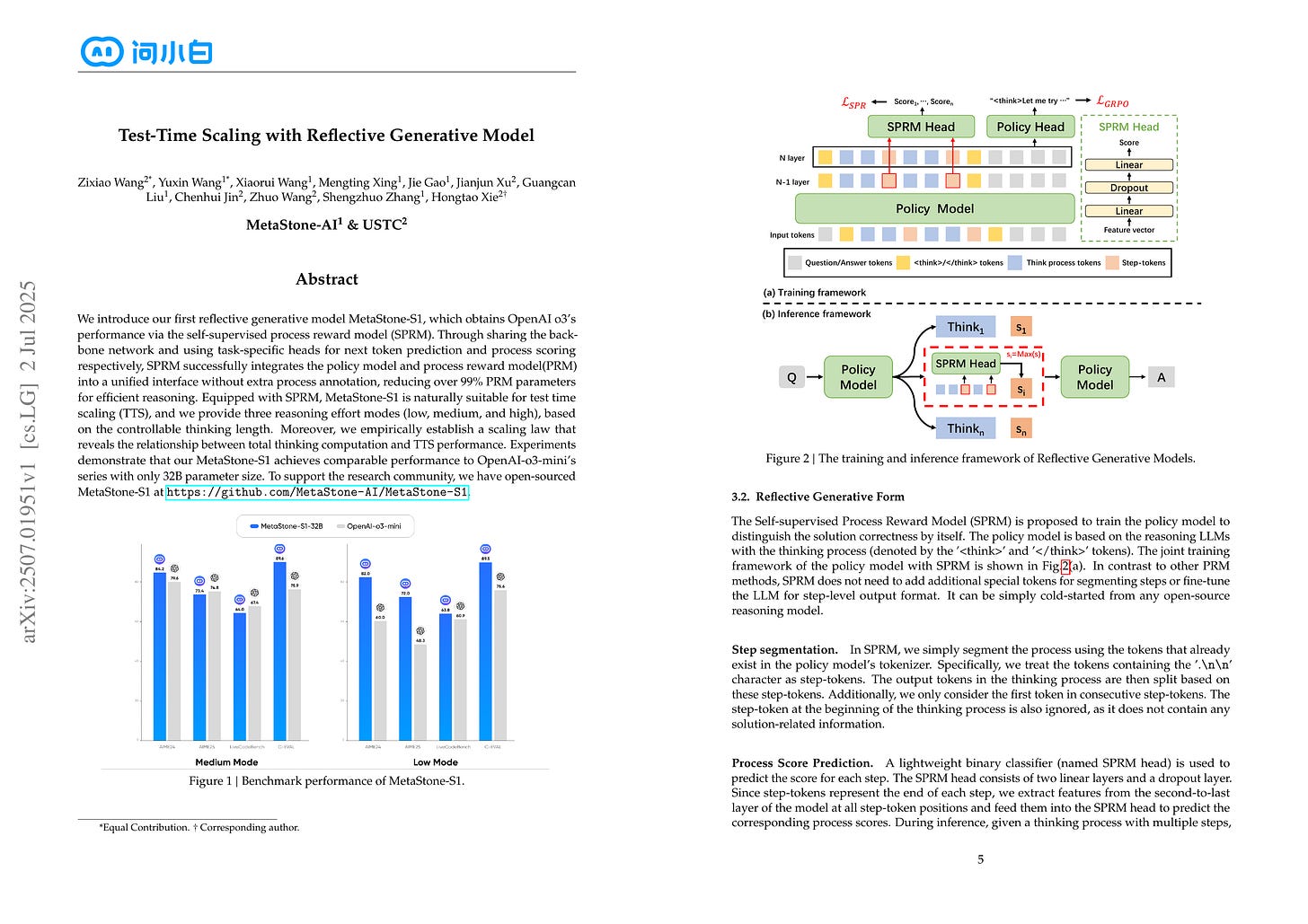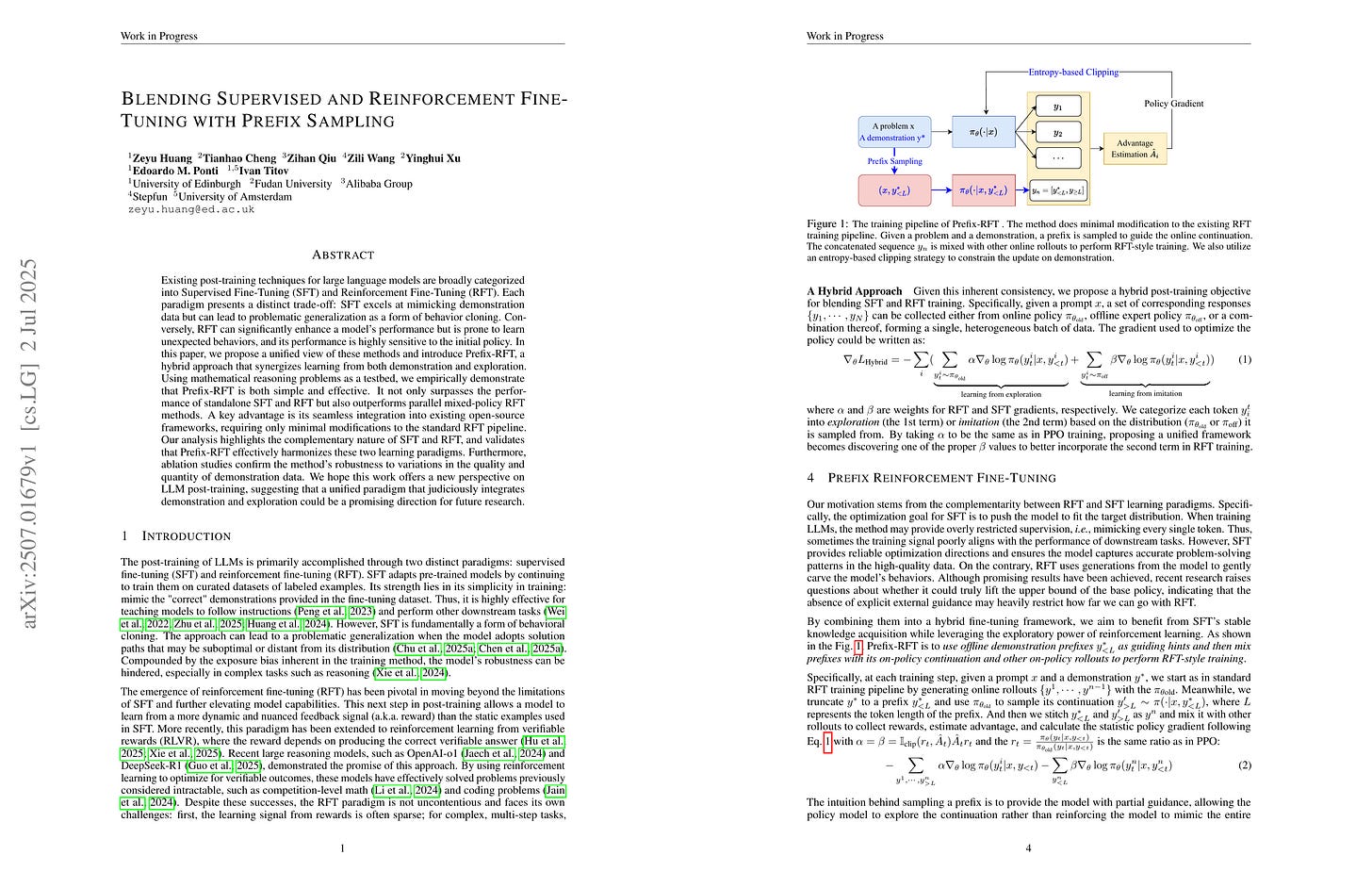2025년 7월 3일
Self-Guided Process Reward Optimization with Masked Step Advantage for Process Reinforcement Learning
(Wu Fei, Hao Kong, Shuxian Liang, Yang Lin, Yibo Yang, Jing Tang, Lei Chen, Xiansheng Hua)
Process Reinforcement Learning~(PRL) has demonstrated considerable potential in enhancing the reasoning capabilities of Large Language Models~(LLMs). However, introducing additional process reward models incurs substantial computational overhead, and there is no unified theoretical framework for process-level advantage estimation. To bridge this gap, we propose Self-Guided Process Reward Optimization~ SPRO), a novel framework that enables process-aware RL through two key innovations: (1) we first theoretically demonstrate that process rewards can be derived intrinsically from the policy model itself, and (2) we introduce well-defined cumulative process rewards and Masked Step Advantage (MSA), which facilitates rigorous step-wise action advantage estimation within shared-prompt sampling groups. Our experimental results demonstrate that SPRO outperforms vaniila GRPO with 3.4x higher training efficiency and a 17.5% test accuracy improvement. Furthermore, SPRO maintains a stable and elevated policy entropy throughout training while reducing the average response length by approximately 1/3, evidencing sufficient exploration and prevention of reward hacking. Notably, SPRO incurs no additional computational overhead compared to outcome-supervised RL methods such as GRPO, which benefit industrial implementation.
PRIME의 (https://arxiv.org/abs/2502.01456) 개선 버전이군요. 별도 Reward Model을 제거하고 Advantage의 추정 방법을 바꿨네요.
An improved version of PRIME (https://arxiv.org/abs/2502.01456). They've removed the separate reward model and changed the method for estimating advantages.
#rl #reasoning #reward-model
Skywork-Reward-V2: Scaling Preference Data Curation via Human-AI Synergy
(Chris Yuhao Liu, Liang Zeng, Yuzhen Xiao, Jujie He, Jiacai Liu, Chaojie Wang, Rui Yan, Wei Shen, Fuxiang Zhang, Jiacheng Xu, Yang Liu, Yahui Zhou)
Despite the critical role of reward models (RMs) in reinforcement learning from human feedback (RLHF), current state-of-the-art open RMs perform poorly on most existing evaluation benchmarks, failing to capture the spectrum of nuanced and sophisticated human preferences. Even approaches that incorporate advanced training techniques have not yielded meaningful performance improvements. We hypothesize that this brittleness stems primarily from limitations in preference datasets, which are often narrowly scoped, synthetically labeled, or lack rigorous quality control. To address these challenges, we present a large-scale preference dataset comprising 40 million preference pairs, named SynPref-40M. To enable data curation at scale, we design a human-AI synergistic two-stage pipeline that leverages the complementary strengths of human annotation quality and AI scalability. In this pipeline, humans provide verified annotations, while large language models perform automatic curation based on human guidance. Training on this preference mixture, we introduce Skywork-Reward-V2, a suite of eight reward models ranging from 0.6B to 8B parameters, trained on a carefully curated subset of 26 million preference pairs from SynPref-40M. We demonstrate that Skywork-Reward-V2 is versatile across a wide range of capabilities, including alignment with human preferences, objective correctness, safety, resistance to stylistic biases, and best-of-N scaling, achieving state-of-the-art performance across seven major reward model benchmarks. Ablation studies confirm that the effectiveness of our approach stems not only from data scale but also from high-quality curation. The Skywork-Reward-V2 series represents substantial progress in open reward models, highlighting the untapped potential of existing preference datasets and demonstrating how human-AI curation synergy can unlock significantly higher data quality.
사람이 작성한 레이블과 LLM, 그리고 Preference Data를 결합해 Preference Data의 규모를 증폭.
Expanding the scale of preference data by using human-labeled data, LLMs, and existing preference data.
#reward-model #synthetic-data
Test-Time Scaling with Reflective Generative Model
(Zixiao Wang, Yuxin Wang, Xiaorui Wang, Mengting Xing, Jie Gao, Jianjun Xu, Guangcan Liu, Chenhui Jin, Zhuo Wang, Shengzhuo Zhang, Hongtao Xie)
We introduce our first reflective generative model MetaStone-S1, which obtains OpenAI o3's performance via the self-supervised process reward model (SPRM). Through sharing the backbone network and using task-specific heads for next token prediction and process scoring respectively, SPRM successfully integrates the policy model and process reward model(PRM) into a unified interface without extra process annotation, reducing over 99% PRM parameters for efficient reasoning. Equipped with SPRM, MetaStone-S1 is naturally suitable for test time scaling (TTS), and we provide three reasoning effort modes (low, medium, and high), based on the controllable thinking length. Moreover, we empirically establish a scaling law that reveals the relationship between total thinking computation and TTS performance. Experiments demonstrate that our MetaStone-S1 achieves comparable performance to OpenAI-o3-mini's series with only 32B parameter size. To support the research community, we have open-sourced MetaStone-S1 at https://github.com/MetaStone-AI/MetaStone-S1.
스텝 단위 Process Reward Model. Policy에 헤드를 하나 붙인 형태이고 Pseudo Label을 써서 학습시키는군요.
A step level process reward model. It attaches an additional head to the policy model and is trained using pseudo labels.
#rl #reward-model #reasoning
Blending Supervised and Reinforcement Fine-Tuning with Prefix Sampling
(Zeyu Huang, Tianhao Cheng, Zihan Qiu, Zili Wang, Yinghui Xu, Edoardo M. Ponti, Ivan Titov)
Existing post-training techniques for large language models are broadly categorized into Supervised Fine-Tuning (SFT) and Reinforcement Fine-Tuning (RFT). Each paradigm presents a distinct trade-off: SFT excels at mimicking demonstration data but can lead to problematic generalization as a form of behavior cloning. Conversely, RFT can significantly enhance a model's performance but is prone to learn unexpected behaviors, and its performance is highly sensitive to the initial policy. In this paper, we propose a unified view of these methods and introduce Prefix-RFT, a hybrid approach that synergizes learning from both demonstration and exploration. Using mathematical reasoning problems as a testbed, we empirically demonstrate that Prefix-RFT is both simple and effective. It not only surpasses the performance of standalone SFT and RFT but also outperforms parallel mixed-policy RFT methods. A key advantage is its seamless integration into existing open-source frameworks, requiring only minimal modifications to the standard RFT pipeline. Our analysis highlights the complementary nature of SFT and RFT, and validates that Prefix-RFT effectively harmonizes these two learning paradigms. Furthermore, ablation studies confirm the method's robustness to variations in the quality and quantity of demonstration data. We hope this work offers a new perspective on LLM post-training, suggesting that a unified paradigm that judiciously integrates demonstration and exploration could be a promising direction for future research.
SFT 데이터를 자른 다음 이후 부분에 대해 Rollout을 생성해 RL 학습에 같이 사용. 탐색 촉진에 사용할 수 있지 않을까 싶네요.
Using SFT data in RL training by slicing the SFT data into prefixes and generate rollouts for the remaining parts. This might be useful for enhancing exploration.
#rl #reasoning
Representation Entanglement for Generation:Training Diffusion Transformers Is Much Easier Than You Think
(Ge Wu, Shen Zhang, Ruijing Shi, Shanghua Gao, Zhenyuan Chen, Lei Wang, Zhaowei Chen, Hongcheng Gao, Yao Tang, Jian Yang, Ming-Ming Cheng, Xiang Li)
REPA and its variants effectively mitigate training challenges in diffusion models by incorporating external visual representations from pretrained models, through alignment between the noisy hidden projections of denoising networks and foundational clean image representations. We argue that the external alignment, which is absent during the entire denoising inference process, falls short of fully harnessing the potential of discriminative representations. In this work, we propose a straightforward method called Representation Entanglement for Generation (REG), which entangles low-level image latents with a single high-level class token from pretrained foundation models for denoising. REG acquires the capability to produce coherent image-class pairs directly from pure noise, substantially improving both generation quality and training efficiency. This is accomplished with negligible additional inference overhead, requiring only one single additional token for denoising (<0.5% increase in FLOPs and latency). The inference process concurrently reconstructs both image latents and their corresponding global semantics, where the acquired semantic knowledge actively guides and enhances the image generation process. On ImageNet 256×256, SiT-XL/2 + REG demonstrates remarkable convergence acceleration, achieving 63× and 23× faster training than SiT-XL/2 and SiT-XL/2 + REPA, respectively. More impressively, SiT-L/2 + REG trained for merely 400K iterations outperforms SiT-XL/2 + REPA trained for 4M iterations (10× longer). Code is available at: https://github.com/Martinser/REG.
클래스 토큰도 디노이징하면서 인코더와 정렬시키는 방법으로 Diffusion 학습 가속. 텍스트에도 적용 가능할지 궁금하네요.
Accelerating diffusion training by denoising class tokens and aligning them with encoder features. I wonder if this method can be applied to text conditioning as well.
#diffusion









